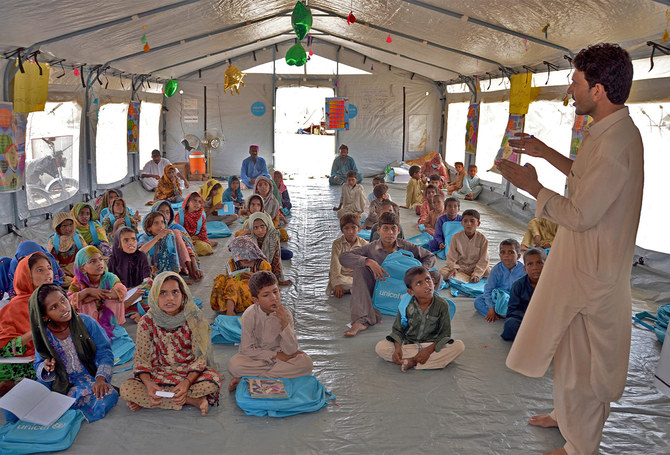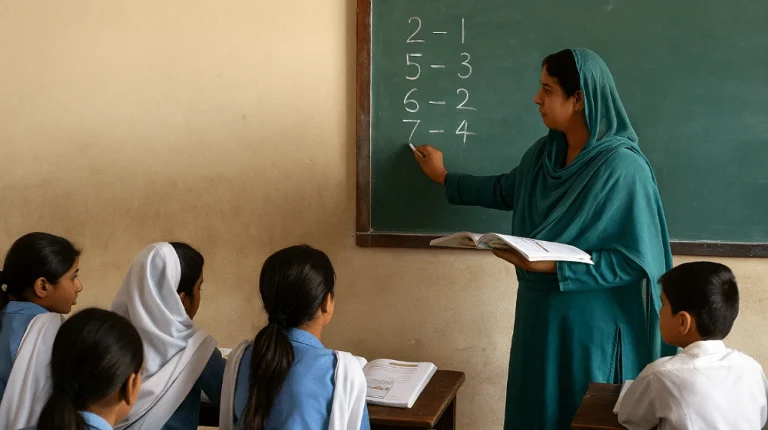The recent floods in Punjab have unleashed a crisis that has shaken the province to its core. Nearly 3000 schools have been destroy throughout the province, according to Punjab Minister for School Education Rana Sikandar Hayat. Threatening the future of education in the impacted areas and depriving thousands of children of classrooms.
The government has been forced to implement emergency measures as a result of the floods which have been characterized as some of the worst in recent history. To guarantee that education goes on in spite of the extensive destruction.
A Devastating Blow to Punjab’s Education Sector
During a meeting with UNICEF Pakistan Representative, Pernille Ironside, Rana Sikandar Hayat shared a sobering update on the disaster scale. He explained that Punjab education system was already struggling with limited resources but the collapse of thousands of schools has created an unprecedented challenge.
Many of the damaged buildings remain submerged, while others have been reduced to rubble displacing tens of thousands of students. Rehabilitating these institutions has become our foremost challenge.
The minister said adding the education department is working tirelessly to provide temporary alternatives. It is impossible to understate how urgent the situation is, since the disruption could ruin the school year for a great number of kids who wish to finish their education.
Temporary Measures to Keep Learning Alive
To avoid a complete halt in education the Punjab government has introduced three shift schooling in functional institutions. This strategy allows displaced students to continue their studies by attending classes at different times of the day. While the plan provides a lifeline it has also created serious overcrowding testing the capacity of teachers and facilities alike.
In addition, the government has announced plans to rent private buildings and set up tent schools in the worst-hit districts. Recognizing the financial strain on families, all students from the flood-affected areas will be exempted from semester fees.
Students of these areas will receive special scholarships to ease their burden. Rana Sikandar Hayat estimated that reconstruction of the damaged schools could take up to three months. Also depending on the pace of water drainage and the availability of funds.
Flooding Brings Widespread Destruction
The impact of the floods has been felt most severely in southern Punjab where breaches at the Noraja Bhutta embankment of the Sutlej River have inundated entire villages in Multan, Lodhran and Bahawalpur. For more than a week stagnant water measuring eight to ten feet deep has surrounded local settlements.
As conditions worsen, villages like Noraja Bhutta, Kotla Chakar, Bahadurpur, Deepal, and Dunyapur are fighting for their lives. According to locals, almost 70% of the homes have already fallen, and if the water does not go away quickly the remaining buildings are in grave danger.
If the water does not drain the rest will fall too warned Altaf Lang, a villager. The standing water has changed color raising fears of a health emergency as diseases begin to spread.
A Growing Humanitarian Crisis
- Access to necessary medical care and clean drinking water has been hampered by floods.
- There is a significant risk to public health because stagnant pools of water have developed into havens for waterborne diseases.
- The lack of efficient drainage is frustrating the local communities who are in dire need of relief.
- Many villagers blame the nearby motorway’s drainage system for worsening the disaster, saying its limited culverts trap floodwater.
- Some residents have called for portions of the motorway to be breached to release the water.
- NHA General Manager Kashif Nawaz rejected this proposal stating that water is flowing through the culverts and protective measures such as placing stones around weak points are already in place.
Government and UNICEF Join Forces
During his meeting with UNICEF representative Punjab’s education minister highlighted the need for international cooperation to restore the education sector. UNICEF has pledged its support to provide emergency schooling solutions ensuring that children do not lose an entire academic year because of the floods.
In order to rebuild schools prepare teachers for emergency learning situations and provide necessary supplies for displaced students. Pernille Ironside reaffirmed UNICEF commitment to collaborating closely with the Punjab government.
This collaboration offers a glimmer of hope to families who fear that their children education might suffer long term setbacks. With UNICEF expertise and the government resolve efforts are underway to lay the groundwork for recovery even as waters remain high in many regions.
Long Term Challenges Ahead
Although the government initial response was prompt experts caution that given the extent of the damage long term planning and consistent investment. It is necessary to restoring vital infrastructure, rehabilitating submerged villages, and rebuilding thousands of schools. It will require both provincial and federal support as well as international aid.
Educationists are particularly concerned about the risk of rising dropout rates. In rural areas where families are already grappling with financial hardships. Children may be pulled out of school to work and support their households. Without quick action the floods could leave a lasting scar on Punjab’s literacy and development goals.
A Call for Swift Action
- Punjab flood set a reminder of the province vulnerability to natural disasters and the need of better planning and infrastructure.
- The government is urged by civil society organizations and education advocates to expedite relief efforts remove standing water and give children education top priority in plans for disaster recovery.
- Nearly 3000 schools have been destroyed, forcing thousands of students to relocate and entire villages are now eight to ten feet under water.
- Important first steps in the healing process include government programs like short term education, healthcare assistance and scholarships.
- Although it will take months or even years to rebuild institutions and lives, taking decisive action now can protect a generation future.
About Parhlo Pakistan
A vibrant digital platform Parhlo Pakistan is dedicated to showcasing the topics and narratives that are most important to the country. Parhlo Pakistan provides incisive coverage on education, society, culture and national development ranging from breaking news to in depth analyses.
Important subjects like the floods in Punjab and their effects on education are given the attention they merit thanks to the website timely and accurate information. By bringing important issues to light we educate our audience and promote fruitful cross communal communication.
Looking Ahead with Hope
The Punjabi people tenacity is evident in spite of the enormous obstacles. Even in the most trying situations, educators, parents and volunteers put forth endless effort to make sure that kids keep learning. A promising future is indicated by the government dedication to reviving the education sector and its collaboration with UNICEF.
In addition to causing unusual levels of devastation Punjab floods demonstrated the province resiliency and solidarity. Punjab can overcome this crisis and give its children the promising future they deserve if it works hard collaborates with other countries and prioritizes education.




